

EDUCATION System in Pakistan
Aug 23, 2014
1.09k likes | 2.91k Views
EDUCATION System in Pakistan. 5 December , 2008. 1. Contents. PART - I Constitution of Pakistan Organization & Functions PART – II Education Scenario Financing Education Policy Other Programmes. 2. Constitution of Pakistan. 3.
Share Presentation
- arab countries
- azam distinguished professorship
- kazakh albai khan university
- education scenario
- concurrent legislative list
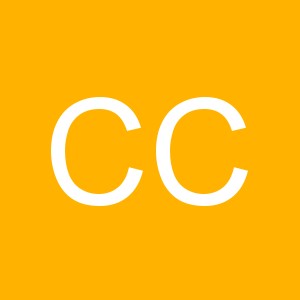
Presentation Transcript
EDUCATION System in Pakistan 5 December , 2008 1
Contents PART - I • Constitution of Pakistan • Organization & Functions PART – II • Education Scenario • Financing • Education Policy • Other Programmes 2
Constitution of Pakistan 3
Constitution of the Islamic Republic of Pakistan, 1973 – Article 37-b “The State shall remove illiteracy and provide free and compulsory secondary education within minimum possible period” Concurrent Legislative List: Curriculum, syllabus, planning, policy, centres of excellence, standard of education & Islamic education 4
Functions and Organizations 5
Major Functions of Ministry of Education Under Rules of Business 1973 • National policies, plans and programmes in education. Development of curricula and textbooks. • International aspects of education. • External examinations. Equivalence of degrees and diplomas. • Education in the Capital, Federally Administered Areas and AJ&K. • Financial assistance to educationists and men of letters. • National libraries. • Boy Scouts and Girl Guides. • Welfare of Pakistani students abroad and foreign students in Pakistan. 6 Continue…
International exchange of students and teachers. • Foreign studies and training. International assistance. • Administration of Selective Federal educational institutions. Act No. X of 1976 provides for Federal supervision of curricula, textbooks and maintenance of standards of education. 7
Millennium Development Goals (2001) 1. Ensuring that by 2015 all children, particularly girls, children in difficult circumstances and those belonging to ethnic minorities, have access to and complete free and compulsory primary education of good quality 2. Eliminating gender disparities in primary and secondary education by 2005, and achieving gender equality in education by 2015, with a focus on ensuring girls’ full and equal access to and achievement in basic education of good quality 8
Functions of Administration Wing • Recruitment / appointments / promotions / transfers / grant of leave and pension to employees of main Ministry. • Rules and regulations for appointments, promotions, transfers etc. in main Ministry. • Maintenance of CR dossiers / ICP Charts / declaration of assets of officers of Ministry. • Disciplinary cases, Courts and Wafaqi Mohtasib cases. • Administrative and financial matters of Federal Board of Intermediate and Secondary Education and Pakistan National Commission for UNESCO, Inter Board Committee of Chairmen, Islamabad. • Administrative matters / budget of Education Division. • Processing of release of funds and reconciliation of expenditure. 9 Continue…
Functions of Administration Wing • Public Accounts Committee, Departmental Accounts Committee, Audit observations and Internal Audits. • Business relating to the Parliament / Cabinet and other organs of State. • Follow-up of President’s and Prime Minister’s Directives. • Inter-Ministerial and Intra-Ministerial Coordination. • Redressal of public grievances relating to Ministry and its organizations. • Matters pertaining to Pakistan Boys Scouts Association and Pakistan Girls Guides Association. • Presidential Awards i.e. Izaz-i-Kamal, Izaz-i-Fazeelat and Izaz-i-Sabqat etc. 10
Functions of Policy & Planning Wing • Formulation of National Policies, Plans and Programs. • Process all development schemes (DDWP, CDWP, ECNEC). • Organize Inter-Provincial Education Secretaries/Ministers' meetings. • Prepare and monitor implementation of PSDP, Medium Term Plan (MTP) and Perspective Plan (PP). • Coordinate release of funds with Finance Div., Planning & Development Div. and AGPR. • Monitoring and evaluating education sector expenditures. • Assist and coordinate with Provincial Education, Finance and Planning Departments and District Governments to develop education sector plans. • Collection of statistics. 11 Continue…
Functions of Policy & Planning Wing • Surveys and research studies. • Laison with development partners, within government and foreign donors and institutions. • Negotiate external economic assistance. • Prepare reports for media, budget speech, Economic Survey, year book etc. • Disseminate government policies, plans, and programs among all development partners and stakeholders. • Develop and Maintain Ministry’s website. • Oversee functioning of Academy for Educational Planning and Management. 12
Functions of Curriculum Wing Curriculum Wing has been empowered through Federal Supervision of Curricula, Textbooks and Maintenance of Standards of Education Act, 1976: To prepare or cause to be prepared [1] schemes of studies, [2] curricula, [3] manuscripts of textbooks and [4] schedules or strategy for their introduction in accordance with the education policy. To approve manuscripts of textbooks produced by other agencies before they are prescribed. To direct any person or agency to delete, amend or withdraw any portion, or the whole, of the curriculum, textbook or reference material. 13
Functions of Projects Wing • Monitoring of projects. • Collaboration between FIUs & PIUs. • Interact with donor agencies/partners/stakeholders. • Evaluation of projects. • Management and release of project funds. • Implementation of various projects (GoP and foreign funded). 14
Functions of Training Wing • Teacher Training and Education-In-service and Pre-service • Training Programmes in collaboration with donors agencies. • Science Olympiads and fairs in collaboration with Intel and universities etc. • Foreign and local scholarships. • International Cooperation and Cultural Exchange Programs. • Coordination / NOC to foreign students for admission in Pakistan on self finance. • Management of educational institutions in ICT. • Administrative, financial and legal matters of following institutions: • National Institute of Science and Technical Education, Islamabad • Federal Directorate of Education, Islamabad • Federal College of Education, Islamabad • Polytechnic Institute for Women, Islamabad 15 Continue…
Functions of Training Wing • National Education Foundation, Islamabad • National Museum of Science and Technical Education, Lahore • Colombo Plan Staff College, Manila, Philippine • Technical Panel on Teacher Education, Islamabad • Dawood College of Engineering and Technology, Karachi • National College of Arts, Lahore • Sindh Madressah-tul-Islam, Karachi • Department of Libraries 16
Functions of Monitoring & Evaluation Cell • To monitor induction of modern education in Madaris and the working of NGO’s. • To improve working of various organizations by suggesting measures based on performance. • To identify areas in which performance has been unsatisfactory, alongwith suggestions for improvement. • Keep Secretary / Minister informed on proper observance and implementation of procedures in various departments, particularly financial discipline. • Monitor and prevent losses due to fraud, misappropriation, pilferage, misuse and theft. • Keep Secretary / Minister informed of any activities prejudicial to the public interest and state of discipline and morale of students and employees. 17
Functions of PMU PMU will closely oversee all stages and aspects of planning, resource mobilization, monitoring and coordination of all development projects including ESR Programme at Federal, Provincial and District level. Main Functions of PMU • Ensure timely release of funds to line departments. • Evolve Monitoring mechanism to gauge the out-puts/out-comes of development Projects. • To collect quarterly monitoring reports containing physical as well as financial achievements. • To ensure optimum and efficient utilization of the budget. • To evaluate achievement of programme objectives and targets. • To suggest and supervise remedial measures to improve effectiveness and efficiency of the programme. 18
Pakistan Chairs Abroad • Quaid-e-Azam Distinguished Professorship at Columbia University, USA. • Quaid-e-Azam Studies Chair, University of California, Berkeley, USA. • Quaid-e-Azam Fellowship, Cambridge University, UK. • Allama Iqbal Fellowship, Cambridge University, UK. • Allama Iqbal Fellowship, Humboldt University, Germany. • Chair in Urdu and Pakistan Studies, Al-Azhar University, Cairo, Egypt. • Chair in Urdu and Pakistan Studies, Ain Shams University, Cairo, Egypt. • Chair in Urdu and Pakistan Studies at Kazakh Albai Khan University of International Relations and World Languages, Almaty, Kazakhistan. 19 Continue…
Pakistan Chairs Abroad • Chair in Urdu and Pakistan Studies, Ankara University, Turkey. • Chair in Urdu and Pakistan Studies, Tehran University, Iran. • Chair in Urdu and Pakistan Studies, Tribhuvan University, Katmandu, Nepal. • Chair in Urdu and Pakistan Studies at Jordan University, Amman. • Chair in Urdu and Pakistan Studies at Peking University, Beijing, China. • Chair in Urdu and Pakistan Studies at Bapist University, Hong Kong. • Allama Iqbal Research chair in Urdu and Arabic, King Saudi University, Saudi Arabia. 20
Area Study Centres For: • Central Asia, University of Peshawar, Peshawar. • South Asia, University of the Punjab, Lahore. • Far East and South East Asia, University of Sindh. • Europe, University of Karachi, Karachi. • Middle East and Arab Countries, University of Balochistan, Quetta. • Africa, North and South America, Quaid-e-Azam University, Islamabad. Pakistan Study Centres at Universities of Punjab, Sindh, Karachi, Peshawar, Quetta & Q. A. University Shaikh Zayed Islamic Centres, University of Punjab, Karachi & Peshawar. 21
Centres of Excellence • Psychology – Quaid-e-Azam University, Islamabad. • Mineralogy – University of Balochistan, Quetta. • Analytical Chemistry – University of Sindh, Jamshoro. • Water Resources Engineering – University of Engineering and Technology, Lahore. • Arts & Design – Mehran University of Engineering and Technology, Jamshoro. • Marine Biology – University of Karachi, Karachi. • History and Culture – Quaid-e-Azam University, Islamabad. • Molecular Biology – University of the Punjab, Lahore. • Gender Studies – Quaid-e-Azam University, Islamabad. • Geology – University of Peshawar, Peshawar. • Physical Chemistry – University of Peshawar, Peshawar. • Solid State Physics – University of the Punjab, Lahore. 22
PART – IIEDUCATION SCENARIO 23
Human Development Index Source: Human Development Reports, 2005-06 & 2007-08, UNDP 24
67% 28% 67% 48% 58% 22% 67% 42% Literacy Rates 47% Pakistan: 55% Male: 67% Female: 42% 58% Literacy Definition (As in 1998 Census) 42% “The ability of a person who can read a newspaper and write a simple letter in any language” 55% 25 Sources: Pakistan Social and Living Standard Measurement (PSLM) Survey 2006-07
Educational Institutions by Level 26 Source: National Education Census 2006, GoP
Institutions by Medium of Instruction 27 Source: National Education Census 2006, GoP
No. of Institutions, Enrolment, Teaching Staff Source: National Education Census (NEC), 2006 28
Enrolment (Million) 29 Source: National Education Census (NEC), 2006
Deeni Madaris (Enrolment and Teaching Staff) Source: National Education Census (NEC), 2006 30
Drop-out Rates Dropouts 2004-05 Enrolment 1999-2000 Dropouts 1999-2000 Enrolment 2004-05 15.7% Class 11-12 0.708 0.111 Class 11-12 0.023 30.14% 0.076 1.479 Class 9-10 15.68% 0.232 0.294 1.311 22.41% Class 9-10 3.323 0.528 Class 6- 8 15.9% 0.753 3.074 24.5% Class 6- 8 14.829 12.480 6.614 Class 1-5 Class 1-5 4.641 53.0% 31.3% Total: 16.941 Million Total: 7.684 Million Total: 20.339 Million Total: 5.512 Million Total children eligible for enrolment (5-16): 44.340 million Children who did not enroll (5-16): 24.001 million 31 Source: 1. National Institute of Population Studies, 2004-05, 2. NEMIS, M/o Education.
81,633 (50%) 57,216 (35%) 53,481 (33%) 46,766 (29%) 9,776 (6%) No Boundary Wall No Drinking Water No Electricity No Toilet No Building Total schools upto Middle level 160,798 PAKISTAN Missing Facilities 32 Source: National Education Census (NEC), 2006
Public Schools in Union Councils 33
Computer and Science Labs in High Schools 34
Financing 35
Financing (Rs. billion) * % of GDP including Private sector budget. Source: Demands for grants, Budget books of Govt. of Punjab, Sindh, NWFP, Balochistan & AJ&K. Federal Ministries/Divisions, District Governments. 36
EDUCATION BUDGET AS % AGE OF GDP (2005-06): SOUTH ASIA Source: EFA Global Monitoring Report 2008 37
Education Policy 38
Challenges • Weakened Governance • Fragmentation • Lack of Clarity in Inter-Tier Relationships • Poor Quality of Teachers & Managers • Quality of curriculum, textbooks & exams • Low level of literacy • Out of school children • Dropouts • Public Private Partnership • In-adequate financing • Gender Equity • Poor monitoring & evaluation • Imbalance in primary, middle & secondary schools • Inconvenient school location 39
SALIENT FEATURES OF NATIONAL EDUCATION POLICY • Universal and Free Primary and Secondary Education • Promotion of Equity • Minimum National Standards • Relevance to Labour Market • Sector Planning • Financial allocation of 7% of GDP by 2018 • Encourage Private sector • Link Allocations to Definition of Free Education • Improve Planning, Management and Implementation Capacity • Donor Harmonisation • Overcoming Fragmented Governance 40 Continue…
Bridging the Public Private Divide • Improved Examination System • Introduction of Early Childhood Education (3-5 years) & inclusive education. • Achieve the MDG goals. • All Primary schools shall be upgraded to Middle level • Well developed plan for expanding school facilities. • High priority to reducing drop out rates • Improved school environment • Career Counselling at higher secondary level • Develop national literacy curriculum • Enhance qualifications for employment as teachers 41 Continue…
Pre-service & in-service teacher training • Accreditation and certification of teachers • Merit based teacher recruitment, professional development, promotions & postings • Curriculum development • Competitive publishing of textbooks and learning materials • District Education Boards to be established for managing schools • Separate management & academic cadres 42
1. Policy Reforms Undertaken i. Highlights of New Scheme of Studies: ‘Islamiat’ as an integrated subject in Classes I-II. Full-fledged subject from Classes III to XII. ‘Ethics’ for non-Muslims. Advanced ‘Islamic Studies’ in Classes IX-XII as an elective subject. General Science compulsory from Classes IV-VIII. Pakistan Studies compulsory upto Class-X. Advance Pakistan Studies as Elective for Classes XI & XII. 43 Continue…
Highlights of New Scheme of Studies e. History, Geography compulsory in Classes VI-VIII. Includes history of sub-continent upto 1947. Post 1947 in Pak Studies. • Computer Literacy compulsory for Classes VI-VIII. ‘Computer Science’ elective subject in Classes IX-X and a Group in Class XI-XII. g. Choice of Arabic / Other Languages, Drawing, Technology, Home Economics, Agriculture in Classes VI to VIII. h. Medical Technology Group (6 subjects) in Classes XI & XII. 44
ii. Review of Curriculum: • Curriculum being updated in view of new Scheme of Studies, challenges of modern world and job market. • Curriculum for 24 core subjects notified. Implementation from 2009. Total subjects 81. 45
iii. New Textbook Policy: Main features are: • improved quality of education through quality textbooks at affordable prices, • competitive publishing of textbooks by public & private publishers, • textbook boards will become facilitating & regulating authorities. Will approve textbooks. • controversial material (cultural, religious, ethnic) shall not be included in textbooks. 46
iv. National Education Assessment System (NEAS) • to improve quality of education at elementary level. • to develop capacity in education assessment. • to measure learning achievements of students in grades IV and VIII. • Based on test results, education system being rehashed. 47
v. Examination System: • Centralized Examination System. • Question papers will have 3 parts: • 20% objective. • 50% short answers. iii. 30% descriptive answers. • Choice reduced to 33%. • Papers based on curriculum, not textbooks. • Teachers being trained to prepare children for new pattern. c. Grace marks reduced from 11 to 3 in max of 2 subjects. 48
vi. Access to Education • Free education and textbooks up to secondary level. • To promote girls' education, future primary schools to be co-education with female teachers only. • Stipends to girl students at Middle level. 49
vii. Governance Reforms • Inter-Provincial Education Ministers' (IPEM) Conference, for uniformity at national level. • Colleges & Technical education schools withdrawn from Districts and placed under Provinces. • Introduction of Prep (ECE) Class. • Regulatory Authority for private educational institutions in Islamabad. • Uniform academic session from 2009. 50 Continue…
- More by User
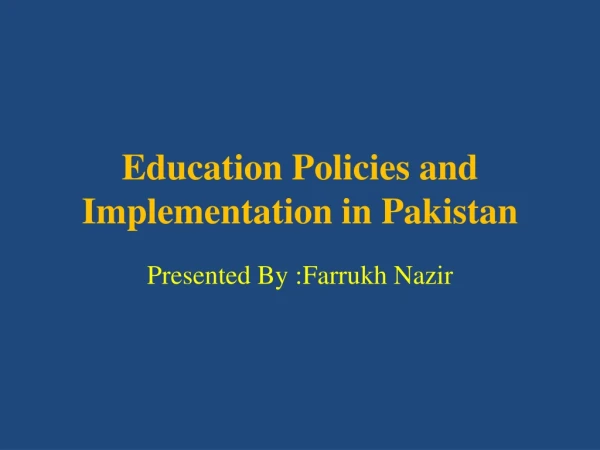
Education Policies and Implementation in Pakistan
Education Policies and Implementation in Pakistan. Presented By :Farrukh Nazir. Education policy.
2.35k views • 52 slides

EDUCATION System in Pakistan. 1. Constitution of Pakistan. 2. Constitution of the Islamic Republic of Pakistan, 1973 – Article 37-b. “ The State shall remove illiteracy and provide free and compulsory secondary education within minimum possible period”. Concurrent Legislative List:
9.26k views • 22 slides

Challenges in the Education Sector in Pakistan
Challenges in the Education Sector in Pakistan. Government of Pakistan Ministry of Education http://www.moe.gov.pk. Challenges in Education System. Challenge # 1: Low level of Literacy
556 views • 17 slides
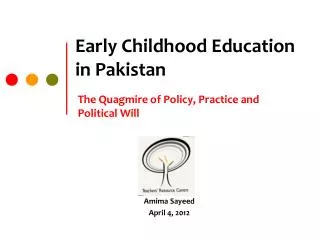
Early Childhood Education in Pakistan
Early Childhood Education in Pakistan. The Quagmire of Policy, Practice and Political Will. Amima Sayeed April 4, 2012. Policies and Provisions: What’s Been Achieved?. National Curriculum aligned with the developmental domains Contextualized, consultative and research based
2.52k views • 10 slides
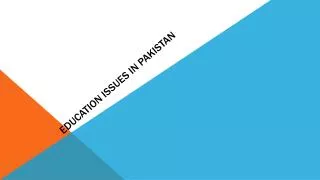
Education issues in Pakistan
Education issues in Pakistan. Uneducated in Pakistan. One out of ten primary school children that are uneducated is located in Pakistan. Pakistan is ranked second in global ranking of out-of-school children. 19.6 million children of primary school age, 6.8 million are not in primary school.
880 views • 9 slides
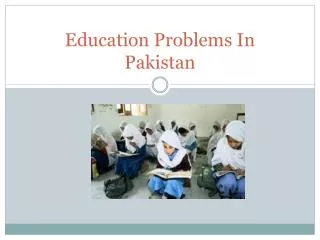
Education Problems In Pakistan
Education Problems In Pakistan. Introduction. Around the world, there are many countries that deny education to certain groups of people because of certain believes and mind sets on what they should not do.
3.88k views • 9 slides
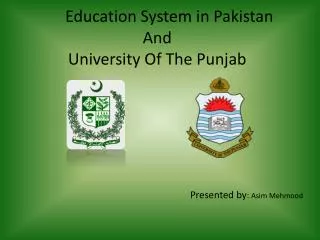
Education System in Pakistan And University Of The Punjab
Education System in Pakistan And University Of The Punjab. Presented by : Asim Mehmood. Pakistan. Education In Pakistan . I n Pakistan education is overseen by Ministry of Education of Government of Pakistan. The academic institutions are the responsibility of provisional government .
537 views • 23 slides
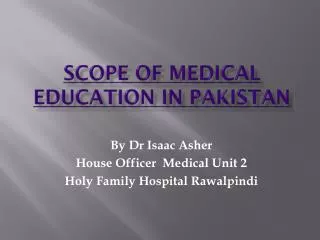
SCOPE OF MEDICAL EDUCATION IN PAKISTAN
SCOPE OF MEDICAL EDUCATION IN PAKISTAN. By Dr Isaac Asher House Officer Medical Unit 2 Holy Family Hospital Rawalpindi. Medicine . The word medicine is derived from the Latin ars medicina , meaning the art of healing
951 views • 12 slides
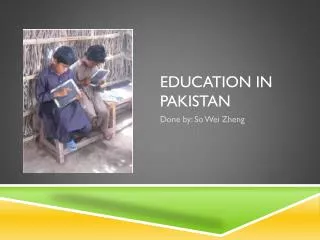
Education in pakistan
Education in pakistan. Done by: So Wei Zheng. deprivation of education (statistics). 51% of Pakistanis are deprived of basic education and health. Between 2000-2004, literacy rates in ages 55-64 was 38%. 45-54 was 46%, 25-34 was 54%, and 15-24 was nearly 57%.
501 views • 10 slides

GHAZALI EDUCATION TRUST PAKISTAN
Education Relief for NWFP IDPs. GHAZALI EDUCATION TRUST PAKISTAN. Summary. As military operation continues in Swat, Dir, Buner and adjacent locations, the residents of these areas are migrating to safer regions like Mardan, Charsadda and Peshawar.
315 views • 15 slides

UNIVERSAL PRIMARY EDUCATION IN PAKISTAN
UNIVERSAL PRIMARY EDUCATION IN PAKISTAN. AZHAR IQBAL KHAN M.Phil Student Iqra University , 01 December , 2013. 2. Constitution of Pakistan. 3. Constitution of the Islamic Republic of Pakistan, 1973 – Article 37-b.
2.33k views • 33 slides

Education System in Pakistan And University Of The Punjab. Presented by : Asim Mehmood. Pakistan. Education In Pakistan. I n Pakistan education is overseen by Ministry of Education of Government of Pakistan. The academic institutions are the responsibility of provisional government .
719 views • 23 slides
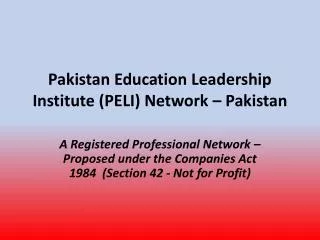
Pakistan Education Leadership Institute (PELI) Network – Pakistan
Pakistan Education Leadership Institute (PELI) Network – Pakistan. A Registered Professional Network – Proposed under the Companies Act 1984 (Section 42 - Not for Profit). Vision. Building Communities of Best Practice for Quality Professional Learning & Leadership across Pakistan and AJK.
475 views • 23 slides

Working for Education in Pakistan
Working for Education in Pakistan. Anum Asi Teachers College Columbia University Global Careers & Education. Wh at continent is my country on?. Enlarge the map of your continent. Karachi.
473 views • 25 slides
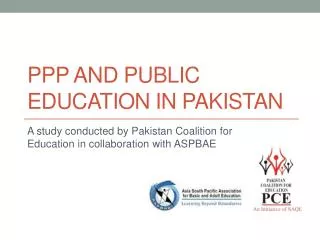
PPP and Public Education in Pakistan
PPP and Public Education in Pakistan. A study conducted by Pakistan Coalition for Education in collaboration with ASPBAE. Introduction. The research is conducted by PCE with the support of in ASPBAE and OSF highlights the Public Private Partnerships (PPP) in Pakistan.
733 views • 23 slides
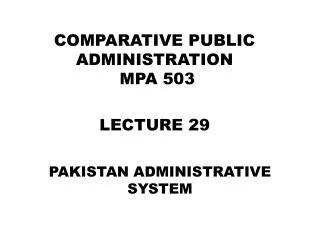
PAKISTAN ADMINISTRATIVE SYSTEM
PAKISTAN ADMINISTRATIVE SYSTEM. COMPARATIVE PUBLIC ADMINISTRATION MPA 503 LECTURE 29. MANAGEMENT IN PAKISTAN. PAKISTAN IS A FEDERAL STATE.
565 views • 25 slides

Food System in Pakistan
Food System in Pakistan. Nazim Ali. Nazim Ali. Global Change Impact Studies Centre Islamabad, Pakistan. Irrigated Landscape of District Gujrat. Wheat Production in Districts of Punjab Pakistan. Gujrat. (SDPI, 2004). Rice Production in Districts of Punjab Pakistan. Gujrat. (SDPI, 2004).
1.21k views • 26 slides
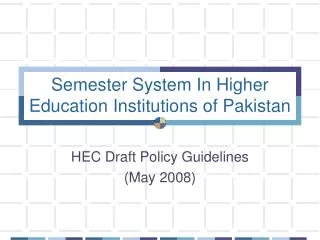
Semester System In Higher Education Institutions of Pakistan
Semester System In Higher Education Institutions of Pakistan. HEC Draft Policy Guidelines (May 2008). Background. Deliberated on two systems (Annual and Semester) Different forms of semester (Bisemester, Trisemester, and term system) in HEI
1.17k views • 31 slides
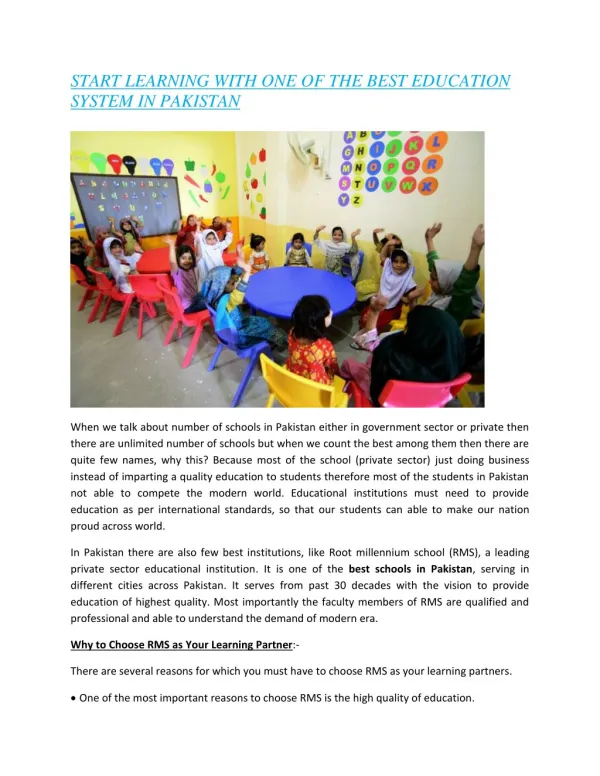
START LEARNING WITH ONE OF THE BEST EDUCATION SYSTEM IN PAKISTAN
When we talk about number of schools in Pakistan either in government sector or private then there are unlimited number of schools but when we count the best among them then there are quite few names, why this? Because most of the school (private sector) just doing business instead of imparting a quality education to students therefore most of the students in Pakistan not able to compete the modern world. Educational institutions must need to provide education as per international standards, so that our students can able to make our nation proud across world.
41 views • 2 slides
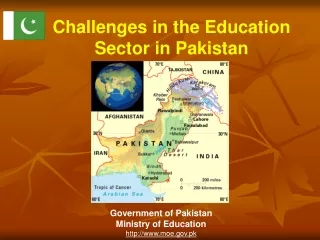
420 views • 17 slides

254 views • 23 slides
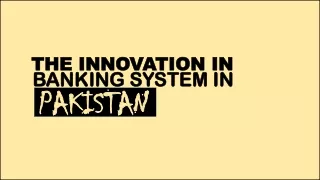
The Innovation In Banking System In Pakistan
The banking system of Pakistan has come a long way from how it was just a decade ago. With strong emphasis on digitizing the many banking facilities, the aim is to fulfill the needs of todayu2019s generation who prefers things on-the-go as compared to the conventional banking system that involved waiting in long lines to pay utility bills, deposit cash, clear a query, etc.
128 views • 8 slides
Education System in Pakistan
Welcome to an exploration of Pakistan’s educational journey, a voyage marked by both accomplishments and challenges. In this article, we’ll embark on a comprehensive tour of Pakistan’s education system, analyzing its setbacks and envisioning the road to academic excellence. Whether you’re a student, a parent, or an education enthusiast, join us as we navigate the educational landscape of Pakistan.
Pakistan’s Three-Tiered Education System
Are you ready for an exciting journey through Pakistan’s education system? Buckle up as we explore this three-tiered adventure that shapes the academic path for students across the country. Whether you’re a student eager to learn or a parent guiding your child’s education, let’s embark on this educational quest together.
Tier One: Primary Education – The First Step
Our journey begins at the primary level, where you take your first steps into the world of learning. Think of it as your starting point, the foundation upon which your educational adventure is built. Primary education is not only crucial but also free and mandatory for all children in Pakistan, at least in theory. However, there’s more to the story.
In rural areas, reaching school can be an expedition in itself, with children often living far from educational institutions. Despite these challenges, primary education serves as the gateway to a world of possibilities, where knowledge opens doors to endless opportunities.
Tier Two: Secondary Education – Navigating the Maze
As we move to the second tier, secondary education reveals itself as a complex and intriguing maze. This phase marks a significant twist in our educational journey. In secondary education, students encounter exams like the Secondary School Certificate (SSC) and Higher Secondary School Certificate (HSSC) – milestones to overcome to continue your adventure.
Tier 3: Higher Education – Shaping Futures
Tier 3 represents the higher education level. It includes universities and colleges, both public and private, offering undergraduate and postgraduate programs. These institutions play a crucial role in shaping the future of Pakistan’s youth, providing them with the knowledge and skills necessary to excel in their chosen careers. Students at this tier can specialize in various fields, from engineering and medical sciences to humanities, business, and social sciences, allowing them to explore their passions and contribute to the nation’s socio-economic growth and development.
But, like any good adventure, this maze isn’t without challenges. Picture it: navigating through the labyrinthine corridors of educational trials, with hurdles like poverty, gender disparities, and infrastructure issues complicating the path. Secondary education is a test of your determination and resilience.
Key Challenges in Pakistan’s Education System
Several factors impede the smooth flow of education in Pakistan:
Quality Education: The Common Thread
One overarching concern permeates Pakistan’s education system at every level – the quality of education. Access is important, but quality is equally critical. Many schools in Pakistan, particularly those in rural and underserved areas, lack basic facilities and well-trained teachers. This poses challenges in preparing students for the demands of the modern world.
The Curriculum Challenge: Adapting to Modern Needs
At the heart of the quality concern lies the need for a modernized curriculum capable of meeting the expectations of contemporary education. Pakistan’s curriculum has struggled to keep pace with changing times, leaving students with outdated knowledge and skills. In contrast, competitor countries have successfully revamped their curricula to prepare their youth for global competitiveness.
Teacher Training: Bridging the Gap
Teacher training remains a critical challenge within Pakistan’s educational system. Teachers are the foundation of quality education, yet many lack the skills, resources, and ongoing training needed to fully engage and empower their students. This deficiency is like embarking on a journey with an ill-prepared guide, impacting student success. Investing in comprehensive teacher training means not only equipping teachers with knowledge, but also providing them with the tools to adapt to modern teaching methods, foster inclusive classrooms, and unlock student potential. By focusing on teacher development, Pakistan can bridge a significant gap and elevate the quality of education across the nation.
The Road Ahead: A Call for Comprehensive Reforms
As we continue our journey through Pakistan’s education system, it becomes evident that while we’ve identified the challenges, substantial and tangible improvements have remained elusive. We stand at a crossroads, and the path ahead calls for comprehensive reforms, increased investment, and collective efforts from all stakeholders.
A Blueprint for Change
Comprehensive reforms encompass a holistic approach to revitalizing Pakistan’s educational landscape. These reforms should address not only curriculum updates and infrastructure enhancements but also teacher training, student support, and equitable access to education. By undertaking these reforms, Pakistan can move closer to achieving a high-quality and universally equitable education system that aligns with modern global standards.
Funding Education
Increased investment in education is a critical component of this transformation. Adequate funding ensures that schools have the resources they need, from well-trained teachers to up-to-date textbooks and modern technology. It’s an investment in the future of Pakistan, one that can yield significant returns in the form of an educated, skilled workforce and a prosperous nation.
Collective Action for Positive Change
Concerted efforts from all stakeholders, including the government, educators, parents, and civil society, are essential. Education is a shared responsibility, and progress can only be achieved through collaboration. This collective commitment can help pave the way for tangible improvements in Pakistan’s education sector.
Empowering Pakistan’s Future Through Education
In conclusion, transforming the education landscape is not merely a matter of policy; it’s a collective responsibility. Collaboration among policymakers, educators, parents, and civil society is crucial to usher in a brighter and more inclusive future for all citizens. While the journey may be long, and the road ahead may be challenging, it’s a path that holds the key to Pakistan’s progress, prosperity, and the fulfillment of the aspirations of its youth.
Sidra Ahmad
Navigating primary education in pakistan: a comprehensive guide, a guide to gre prep for pakistani graduates, related articles.
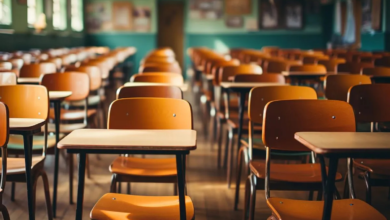
Leave a Reply Cancel reply
Your email address will not be published. Required fields are marked *
Save my name, email, and website in this browser for the next time I comment.
WhatsApp us
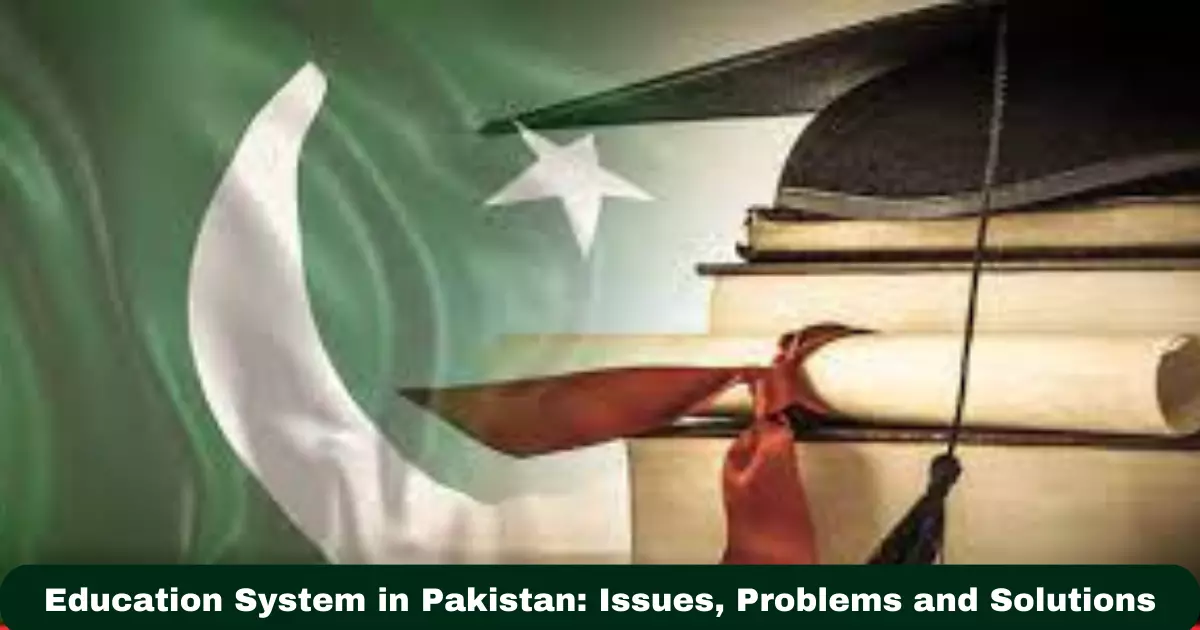
Education System in Pakistan: Issues, Problems and Solutions
Welcome to an exploration of Pakistan’s education system : its challenges, its promises, and the path forward. This article dissects the issues plaguing education, offers solutions, and dives into the diverse landscape of learning in Pakistan.
Join us in uncovering the hurdles, understanding the complexities, and discovering the solutions vital for transforming education in this dynamic nation.”
Issues Impacting Education
Education in Pakistan faces multifaceted challenges, hindering its progress and impeding the fulfillment of crucial global commitments. Understanding these issues is pivotal in devising effective solutions.
Meeting MDGs and Pakistan’s Status:
Pakistan is dedicated to attaining the Millennium Development Goals (MDGs) which encompass achieving education. However, despite making progress the country faces challenges in meeting these objectives. Issues, like poverty, gender inequality, and insufficient infrastructure pose barriers, to accessing quality education in regions and marginalized communities. This discrepancy between commitment and reality highlights a critical issue that needs urgent attention.
Challenges with Education for All Commitment:
The Education for All (EFA) commitment remains a formidable challenge. While strides have been made in increasing enrollment, retention rates, teacher quality, and curriculum relevance remain problematic. Disparities in education persist based on gender, socio-economic status, and geographical location, posing significant hurdles to achieving comprehensive education for all.
Vision 2030 and Education Goals:
Vision 2030 outlines ambitious goals for Pakistan’s development, including educational reforms. However, inadequate policy implementation, insufficient budget allocation, and bureaucratic hurdles hamper progress. Bridging the gap between vision and execution is essential for realizing sustainable advancements in the education sector.
These issues collectively illustrate the systemic challenges embedded in Pakistan’s education system. Tackling these hurdles demands a holistic approach, addressing infrastructure gaps, socio-economic disparities, policy execution, and societal mindsets toward education. The subsequent sections will delve into specific problems within various educational tiers and propose actionable solutions to combat these pressing issues.
Identified Problems
The educational landscape in Pakistan is marred by a spectrum of challenges across different tiers, hindering the holistic development of its populace.

Primary, Middle, and Secondary Education Challenges:
Challenges, in education include facilities, a shortage of qualified teachers, and low enrollment rates, particularly in rural areas. Middle and secondary education encounter difficulties such, as dropout rates, outdated curricula, and limited availability of quality learning materials. These challenges perpetuate an environment where foundational knowledge and skills remain deficient among a significant portion of the population.
Vocational and Tertiary Education Issues:
Vocational education encounters a lack of emphasis and recognition, leading to a dearth of skilled labor. Tertiary education confronts challenges related to limited access to quality institutions, outdated teaching methodologies, and a mismatch between curriculum and industry needs. These factors hinder the country’s ability to produce a competitive, skilled workforce equipped for a rapidly evolving job market.
Issues with Secondary/Higher Secondary Education System:
The secondary and higher secondary education system struggles with disparities in quality between public and private institutions. Moreover, the emphasis on rote learning over critical thinking stifles creativity and innovation among students. Standardized testing and assessment methodologies often fail to evaluate holistic learning, focusing primarily on memorization.
The Role of Community Colleges:
Community colleges intended to bridge the gap between secondary education and higher learning, face challenges in recognition, funding, and curriculum relevance. Lack of awareness and support limits their efficacy in offering diverse educational opportunities beyond traditional pathways.
Addressing these problems necessitates a comprehensive overhaul of educational policies, infrastructure development, teacher training, curriculum redesign, and a shift in societal perspectives towards alternative educational pathways. The subsequent section will outline actionable solutions and recommendations aimed at tackling these entrenched issues to foster a more robust and inclusive educational system in Pakistan.
Read more about: Scope of MBA In Pakistan: Perfect Guide
Solutions and Recommendations
Resolving the intricate issues entrenched within Pakistan’s education system demands a multifaceted approach, combining policy reforms, infrastructure enhancement, and a paradigm shift in educational practices.
Revamping Primary, Middle, and Secondary Education:
- Infrastructure Improvement: Investing in infrastructure upgrades in rural areas, ensuring schools have adequate facilities and are accessible to all communities.
- Teacher Training and Support: Enhancing teacher training programs, incentivizing qualified educators to work in remote areas, and ensuring ongoing professional development.
- Curriculum Enhancement: Updating curricula to be more relevant, inclusive, and aligned with modern pedagogical approaches, focusing on critical thinking and practical skills.
Enhancing Vocational and Tertiary Education:
- Promoting Vocational Training: Elevating the status of vocational education, expanding vocational training centers, and forging industry partnerships for practical skill development.
- Quality Assurance in Tertiary Institutes: Implementing rigorous quality standards in tertiary institutions, updating course content to meet industry demands, and fostering research and innovation.
Strengthening Community Colleges:
- Awareness and Promotion: Raising awareness about the benefits of community colleges, promoting their role in providing alternative educational pathways, and ensuring their accreditation and integration within the broader educational framework.
- Expanding Curriculum Options: Diversifying course offerings in community colleges to cater to a wide array of interests and career paths, incorporating practical, job-oriented skills.
Strategies for Improvement in Higher Education:
- Industry-Academia Collaboration: Promoting collaborations, between institutions and businesses to synchronize the curriculum with the demands of the job market guaranteeing that graduates acquire the necessary skills.
- Research and Innovation: Promoting the development of research infrastructure, cultivating a climate of creativity and ingenuity, and providing incentives for research endeavors to stay on par with progress.
When these solutions are implemented together in a manner they have the potential to bring about a transformation, in the education system of Pakistan. However, it is crucial for the government, educational institutions, civil society, and the private sector to work together diligently and make progress to ensure development in the field of education.
Education Landscape in Pakistan
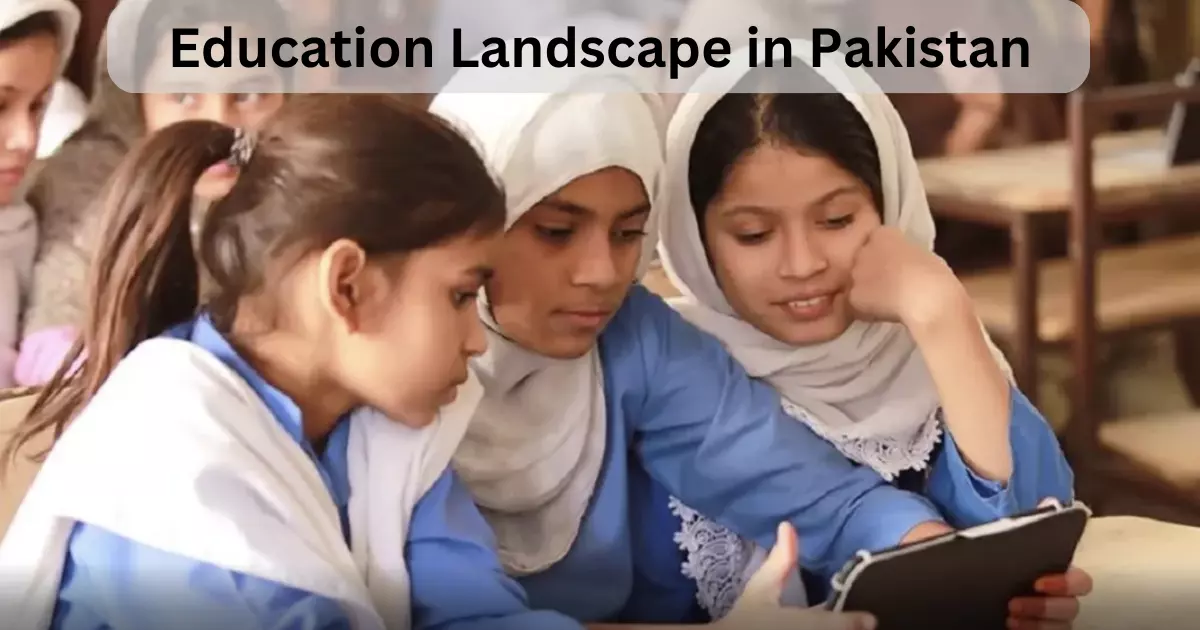
Understanding the historical context, current allocations, and various stages of formal education elucidates the intricate tapestry of Pakistan’s educational system.
Historical Context of Education:
- Early Educational Systems: Pakistan’s educational journey traces back to ancient civilizations, with an early emphasis on religious education and centers of learning.
- Colonial Influence: British rule introduced a formal education system, primarily serving the elite, leading to a disparity in educational access and quality among different societal strata.
Government’s Budgetary Allocation for Education:
- Budgetary Trends: Analyzing the government’s allocation for education over the years, highlighting any fluctuations, trends, or inadequacies.
- Impact of Budgetary Policies: Understanding the correlation between budgetary allocations, infrastructure development, and educational outcomes.
Different Stages of Formal Education:
- Primary Education: Describing the foundational stage of education, its importance, challenges, and enrollment statistics.
- Secondary Education: Exploring the transition from primary to secondary education, challenges faced, and the impact on future opportunities.
- Tertiary Education: Investigating the landscape of higher education, including universities, colleges, and their contributions to workforce development.
- Quaternary Education: Examining specialized higher education, research institutions, and their role in advancing knowledge and innovation.
- Non-formal and Informal Education: Recognizing alternative learning pathways, their significance in addressing educational disparities, and their integration within the formal system.
- Madrassas: Understanding the role, challenges, and reforms in religious educational institutions.
Analyzing these different facets provides a comprehensive overview of Pakistan’s educational landscape, shedding light on the strengths, weaknesses, and opportunities present within the system. This understanding is crucial for devising targeted interventions and policies aimed at fostering a more inclusive, accessible, and effective education system in the country.
Know more: BBA Scope in Pakistan – Your Ultimate Career Game Changer
Focus Areas for Progress
Within Pakistan’s education system, specific sectors and initiatives require focused attention to drive meaningful progress and ensure comprehensive development.
Degree Awarding Institutions/Universities in Pakistan:
- Quality and Accreditation: Evaluating the caliber of universities and colleges and the criteria, for accreditation. How they influence brilliance and career prospects.
- Research and Innovation: Universities play a role, in driving knowledge and technology showcasing their research output, and fostering innovation hubs.
Technical & Vocational Education and Training (TVET):
- Aligning with Industry Needs: Strengthening TVET programs to meet the demands of evolving industries, ensuring graduates possess practical skills and are job-ready.
- Promoting Vocational Training: Encouraging the perception shift towards vocational education, emphasizing its importance in national development.
Skill Development and Incubation Centers:
- Entrepreneurship and Skill Enhancement: Empowering youth through skill development programs, fostering an entrepreneurial mindset, and establishing incubation centers for startups and innovation.
- Partnerships and Support: Collaborating with private enterprises and government initiatives to support skill development and incubation programs.
Government Policies and Initiatives:
- Policy Analysis: Evaluating existing educational policies, their efficacy, implementation challenges, and potential areas for improvement.
- Initiatives for Access: Highlighting government initiatives aimed at increasing access to education, addressing disparities, and promoting inclusivity.
Market Insights:
- Aligning Education with Market Demands: Understanding market trends, skills in demand, and aligning educational curricula to bridge the gap between academia and industry.
- Employment Opportunities: Exploring job prospects, identifying sectors with growth potential, and preparing students accordingly.
Focusing on these areas presents opportunities for targeted interventions and strategic investments, fostering a more responsive, inclusive, and dynamic educational ecosystem in Pakistan. Collaboration among stakeholders, innovative approaches, and a commitment to addressing these focal points can pave the way for a brighter future for education in the country.
Conclusion
Pakistan’s education system stands at a critical juncture, grappling with myriad challenges while holding immense potential for transformation. From issues in access and quality across different educational tiers to the need for policy reforms, infrastructure enhancements, and a paradigm shift in educational practices, the landscape is complex and multifaceted.
However, within these challenges lie opportunities for progress and innovation. By implementing the outlined solutions, focusing on key sectors, and fostering collaborative efforts among stakeholders, Pakistan can pave the way for a more inclusive, accessible, and effective educational system.
It’s a collective responsibility to invest in education, a fundamental cornerstone for societal growth, economic prosperity, and individual empowerment. The journey toward an improved education system requires sustained dedication, visionary leadership, and a commitment to nurturing the potential of every learner, ensuring a brighter future for generations to come.
Inadequate infrastructure, low budget, outdated curricula, and a shortage of qualified teachers.
Girls face barriers; solutions include gender-sensitive curricula, improved infrastructure for girls’ schools, and changing societal attitudes.
Poverty prevents attendance; solutions include need-based scholarships, increased funding in low-income areas, and free or subsidized textbooks.
Insufficient training affects quality; solutions include ongoing teacher training, updated methodologies, and incentives for professional development.
Outdated curricula hinder relevance; solutions include a comprehensive overhaul, modern teaching methods, and collaboration with industry experts.
Limited access hinders tech use; solutions include digital learning initiatives, infrastructure investment, and training for teachers and students.
Share this post:
Recommended, education in pakistan – a comprehensive overview, interview preparation for cabin crew jobs in pakistan: ultimate guide, 10 best air hostess course training institutes in pakistan, top 16 icom colleges in lahore: which ones are the best, top 12 colleges for icom in faisalabad: private and government options, what are the career options after completing mbbs in pakistan, top 10 medical colleges in pakistan: private & government guide, what is mdcat test in pakistan for mbbs: eligibility, subjects, preparation tips, judiciary exams in pakistan: eligibility, structure, and study resources, top 10 books, online resources, and coaching tips for css exam preparation in pakistan, step-by-step registration process for the css exam on fpsc portal.
- Bahrain Education
- Chinese language Institutes
- Commerce Education
- Computer Colleges
- Dubai Education
- English Course Institutes
- German Language Institutes
- Higher Secondary Education
- Korean Language Course and Institutes
- Language Proficiency Institutes
- Primary Education
- UAE IELTS Institutes
- YouTube Learning Channels
School Education System in Pakistan
Expansion, Access, and Equity
- Reference work entry
- First Online: 29 August 2021
- Cite this reference work entry

- Anjum Halai 3 &
- Naureen Durrani 4
Part of the book series: Global Education Systems ((GES))
1914 Accesses
4 Citations
In Pakistan, all children between 5 and 16 years of age have the right to 12 years of school education. The public school system is the main provider of schooling. Pakistan takes explicit account of gender in the provision of schooling, especially in public schools at post-primary levels, with girls’ schools with female teachers and boys’ schools with male teachers.
While the policy context has always been supportive of universal school education, there is a significant gap in access, especially for girls at post-primary levels. The private sector has an increasingly large share in education with strong public–private partnership models to enhance access to quality education for the needy. Mostly, the medium of instruction is Urdu in public schools and English in private schools.
This chapter describes the school education system in Pakistan and provides insights into issues of access, expansion, and equity in the specific sociocultural and language context of the country.
This is a preview of subscription content, log in via an institution to check access.
Access this chapter
Subscribe and save.
- Get 10 units per month
- Download Article/Chapter or eBook
- 1 Unit = 1 Article or 1 Chapter
- Cancel anytime
- Available as PDF
- Read on any device
- Instant download
- Own it forever
- Available as EPUB and PDF
- Durable hardcover edition
- Dispatched in 3 to 5 business days
- Free shipping worldwide - see info
Tax calculation will be finalised at checkout
Purchases are for personal use only
Institutional subscriptions
Similar content being viewed by others

School Education in Afghanistan

Secondary Education in Maharashtra: Issues of Concern
AEPAM. (2013). Pakistan Education Statistics 2012–13. Academy of Education Planning and Management (AEPAM) . Islamabad: Ministry of Professional and Technical Training Government of Pakistan. Retrieved from http://library.aepam.edu.pk/ .
Ahmad, V., & Zeeshan, M. (2014). An analysis of the social impact of the stipend program for secondary school girls of Khyber Pakhtunkhwa. Educational Research for Policy and Practice, 13 , 129–143.
Article Google Scholar
Ahmed, S. A. Cho, Y., & Fasih, T. (2019). Pakistan@100 human capital. Policy note. World Bank Group. Retrieved April 9, 2020, from http://documents.worldbank.org/curated/en/181471552638661744/pdf/135324-14-3-2019-20-35-15-PakPNHumanCapitalLaunchFinal.pdf
Aly, J. (2007). Education in Pakistan: A white paper: Revised: Document to debate and finalize the national education policy. Retrieved December 19, 2018, from http://planipolis.iiep.unesco.org/sites/planipolis/files/ressources/pakistan_national_education_policy_review_whitepaper.pdf
Amjad, R., & MacLeod, G. (2014). Academic effectiveness of private, public and private–public partnership schools in Pakistan. International Journal of Educational Development, 37 (1), 22–31.
Andrabi, T., Das, J., & Khwaja, A. J. (2008). A dime a day: The possibilities and limits of private schooling in Pakistan. Comparative Education Review, 52 (3), 329–353.
ASER. (2019). Annual Status of Education Report 2018 (provisional) . Islamabad: Idara Taleem O Agahi. Retrieved March 6, 2020, from http://aserpakistan.org/document/aser/2018/reports/national/ASER_National_2018.pdf
ASER-Pakistan. (2017). Annual Status of Education Report (ASER) 2017 . Islamabad: South Asian Forum for Education Development. Retrieved from http://aserpakistan.org/report .
Ashley, D., Mcloughlin, C., Aslam, M., Engel, J., Wales, J., Rawal, S., Batley, R., Kingdon, G., Nicolai, S., & Rose, P. (2014). The role and impact of private schools in developing countries: A rigorous review of the evidence. Final report. Education Rigorous Literature Review. Department for International Development. The EPPI-Centre reference number for this report is 2206.
Google Scholar
Asian Development Bank. (2019). School education in Pakistan: A sector assessment . Manila: Asian Development Bank. https://doi.org/10.22617/TCS190039 . Retrieved February 6, 2019, from https://www.adb.org/documents/pakistan-school-education-sector-assessment . ISBN 978-92-9261-528-4 (print), 978-92-9261-529-1 (electronic).
Book Google Scholar
Aslam, M., & Kingdon, G. (2008). Gender and household education expenditure in Pakistan. Applied Economics, 40 (20), 2573–2591.
Aslam, M., & Kingdon, G. (2012). Can education be a path to gender equality in the labour market? An update on Pakistan. Comparative Education, 48 (2), 211–229. https://doi.org/10.1080/03050068.2011.608898 .
Aslam, M., Rawal, S., & Sahar, S. (n.d.). Public private partnerships in education in developing countries. A rigorous review of literature. Retrieved April 6, 2020, from https://arkonline.org/sites/default/files/Ark_EPG_PPP_report.pdf
Bray, M. (1983). Universal education in Pakistan: A perpetually elusive goal? International Review of Education, 29 , 167–178. https://doi.org/10.1007/BF00597991 .
Channa, A. (2011). Can school decentralization improve learning? Autonomy, participation and student achievement in rural Pakistan. Working papers series no. 11–115. ISSN 1470–2320. Retrieved March 6, 2020, from https://www.files.ethz.ch/isn/135133/WP115.pdf
Dawn. (2019, July 19). Urdu to be medium of instruction in primary schools. https://www.dawn.com/news/1496641
Durrani, N., & Halai, A. (2018). Dynamics of gender justice, conflict and social cohesion: Analysing educational reforms in Pakistan. International Journal of Educational Development, 61 , 27–39.
Durrani, N., & Halai, A. (2020). Gender equality, education, and development: Tensions between global, national, and local policy discourses in postcolonial contexts. In A. Wulff (Ed.), Grading goal four: Tensions, threats and opportunities in the sustainable development goal on quality education (pp. 65–95). Leiden: Brill Publishers. https://doi.org/10.1163/9789004430365_003 .
Chapter Google Scholar
Durrani, N., Halai, A., Kadiwal, L., Rajput, S. K., Novelli, M., & Sayed, Y. (2017). Education and social cohesion in Pakistan. Project report. UNICEF. http://sro.sussex.ac.uk/id/eprint/67152/1/__smbhome.uscs.susx.ac.uk_dm50_Desktop_Pakistan%20Summary%20Report_March2017.pdf
Gordon, R. G. Jr (2005). Ethnologue: Languages of the world (15th ed.). Dallas: SIL International. Online version http://www.ethnologue.com
Government of Pakistan. (1977). The fifth plan 1977–1983 (Vol. 2). Islamabad: Planning Commission.
Government of Pakistan, Pakistan Bureau of Statistics. (2015). Pakistan Social and Living Standards Measurement Survey (PSLM) 2013–2014. Islamabad. Retrieved April 9, 2020, from http://www.pbs.gov.pk/sites/default/files//pslm/publications/pslm2013_14/A%20report%2013-14%28%2012-05-15%29_FInal_1.pdf
Halai, A. (2009). Politics and practice of learning mathematics in multilingual classrooms: Issues for policy and practice. In R. Barwell (Ed.), Multilingualism in mathematics classrooms: Global perspectives (pp. 47–62). London: Multilingual Matters. ISBN-13: 978-1-84769-205-4 (hbk) ISBN-13: 978-1-84769-204- (pbk).
Halai, A. (2011). Equality or equity: Gender awareness issues in secondary schools in Pakistan. International Journal of Educational Development, 3 (1), 44–49.
Halai, A., & Muzaffar, I. (2015). Language of instruction and learners’ participation in mathematics: Dynamics of distributive justice in the classroom. In A. Halai & P. Clarkson (Eds.), Teaching and learning mathematics in multilingual classrooms: Issues for policy and practice (pp. 57–72). Rotterdam: SENSE Publishers. ISBN 978-94-6300-228-8.
I-SAPS. (2010). Private sector education in Pakistan: Mapping and musing . Islamabad: Institute of Policy Sciences (I-SAPS). ISBN: 978-969-9393-05-1. Retrieved February 5, 2020, from http://isaps.org/upload/report_publications/docs/1401025704.pdf
I-SAPS. (2013). Public financing of education in Pakistan: Analysis of federal, provincial and district budgets 2010–11 to 2013–14 . Islamabad: Institute of Policy Sciences (I-SAPS). Retrieved April 11, 2020, from http://i-saps.org/upload/report_publications/docs/1402576195.pdf
I-SAPS. (2016a). Public financing of education in Pakistan: Analysis of federal, provincial and district budgets 2010–11 to 2016–17 . Islamabad: Institute of Policy Sciences (I-SAPS). Retrieved April 9, 2020, from http://i-saps.org/upload/report_publications/docs/1496496299.pdf
I-SAPS. (2016b). Gender responsive financing of education in Pakistan: A comparative analysis of Punjab and Sindh . Islamabad: I-SAPS.
Jacoby, H. G., & Mansuri, G. (2011). Crossing boundaries: Gender, caste and schooling in rural Pakistan. Policy research working paper 5710. The World Bank. http://documents.worldbank.org/curated/en/941421468073730366/pdf/WPS5710.pdf . Accessed 15 Mar 2020.
Khan, A., Zuberi, S., Mehmood, R., & Khan, R. (2015). Best practices in girls’ enrolment in Pakistan. The Citizens Foundation: A case study. Retrieved March 06, 2020, from http://www.researchcollective.org/Documents/TCF_UNGEI_Final.pdf
Lall, M. (2009). Creating agents of positive change. The Citizens Foundation in Pakistan. https://www.researchgate.net/publication/241616857 . Accessed 22 Feb 2020.
Lewis, M. P. (2009). Ethnologue: Languages of the world (16th ed.). Dallas: SIL International. http://www.ethnologue.com/
Lloyd, C. B., Mete, C., & Sathar, Z. A. (2005). The effect of gender differences in primary school access, type, and quality on the decision to enrol in rural Pakistan. Economic Development and Cultural Change, 53 (3), 685–710.
Malik, S., & Bibi, N. (2011). A study of contribution of Aga Khan Education Services Pakistan for primary education. Asian Social Science, 7 (8), 254.
MET and SHE. (2013). National plan of action 2013–2016: Achieving universal primary education in Pakistan. MDG acceleration framework. Ministry of Education, Trainings and Standards in Higher Education.
Ministry of Education. (1959). Report of the Commission on National Education . Karachi: Ministry of Education, Government of Pakistan.
Ministry of Education. (1972). National Education Policy 1972–80 . Islamabad: Ministry of Education, Government of Pakistan.
Ministry of Education. (1979). National Education Policy and implementation programme . Islamabad: Ministry of Education, Government of Pakistan.
Ministry of Education. (1992). National Education Policy . Islamabad: Ministry of Education, Government of Pakistan.
Ministry of Education. (1998). National Education Policy 1998–2010 . Islamabad: Ministry of Education, Government of Pakistan.
Ministry of Education (2009). National Education Policy . Islamabad: Ministry of Education, Government of Pakistan. Retrieved October 26, 2014, from http://www.moe.gov.pk/
Ministry of Education. (2014). Education for all 2015. National review report, Pakistan.
Ministry of Education and Scientific Research. (1970). The New Education Policy . Islamabad: Ministry of Education and Scientific Research, Government of Pakistan.
Ministry of Federal Education and Professional Training. (2017). Draft National Education Policy 2017–2025 . Islamabad: Ministry of Federal Education and Professional Training, Government of Pakistan. Retrieved March 14, 2020, from http://mofept.gov.pk/Policies
Ministry of Interior. (1947). Proceedings of the Pakistan educational conference, Nov 27–Dec 1, 1947 . Karachi: Ministry of the Interior (Education Division), Government of Pakistan.
Mughal, A. W., Aldridge, J., & Monaghan, M. (2019). Perspectives of dropped-out children on their dropping out from public secondary schools in rural Pakistan. International Journal of Educational Development, 66 , 52–61. https://doi.org/10.1016/j.ijedudev.2019.02.004 .
NEMIS–AEPAM. (2015a). Pakistan Education Atlas 2015 . Islamabad: Ministry of Federal Education and Professional Training.
NEMIS–AEPAM. (2015b). Pakistan Education Statistics 2013–14 . Islamabad: Ministry of Federal Education & Professional Training.
NEMIS–AEPAM. (2018). Pakistan Education Statistics 2016–17 . Islamabad: National Education Management Information System–Academy of Educational Planning and Management Ministry of Federal Education and Professional Training, Government of Pakistan. Retrieved February 21, 2020, from http://library.aepam.edu.pk/Books/Pakistan%20Education%20Statistics%202016-17.pdf
Newman, J. (2012). Human Opportunity Index (HOI) – National equality of children’s opportunities in Pakistan . Washington, DC: The World Bank.
Pakistan Bureau of Statistics. (2014). Compendium on gender statistics of Pakistan . Islamabad: Pakistan Bureau of Statistics, Government of Pakistan.
Pakistan Bureau of Statistics. (n.d.). Pakistan statistical year book 2018 (provisional) . Islamabad: Pakistan Bureau of Statistics, Government of Pakistan. Retrieved February 24, 2020, from http://www.pbs.gov.pk/sites/default/files//PAKISTAN%20STATISTICAL%20YEAR%20BOOK%202018.pdf
Pardhan, S., Shah, A., Saad, S., Panah, K., Zaman, M., & Khan, K. (2012). A journey of transformation: A reflective recount of the evolution of AKES’P. In In search of relevance and sustainability of educational change: An international conference at Aga Khan University Institute for Educational Development, Nov 1–3, 2012 , pp. 482–487. Available at: http://ecommons.aku.edu/pakistan_ied_pdck/227
PEELI. (2013). Punjab Education and English Language Initiative. British Council Pakistan. https://www.britishcouncil.pk/sites/default/files/can_english_medium_education work in Pakistan British council 2013.pdf
Rahman, T. (1997). The medium of instruction controversy in Pakistan. Journal of Multilingual and Multicultural Development, 18 (2), 145–154. https://doi.org/10.1080/01434639708666310 .
SAHE. (2013). Policy and practice: Teaching and learning in English in Punjab schools . Lahore: Society for Advancement of Education (SAHE). https://www.sef.org.pk
SAHE. (2014). Teaching and learning English in Sindh school . Lahore: Society for Advancement of Education (SAHE). http://www.sahe.org.pk/wp-content/uploads/2016/08/Teaching-and-Learning-English-in-Sindh-Schools-2014-1.pdf . Accessed 06 Mar 2020.
SAHE. (2015). Education Monitor. Education in Pakistan: The state’s engagement with the private sector . Lahore: Society for Advancement of Education. https://www.sahe.org.pk/policy-brief-education-monitor-the-states-engagement-with-the-private-sector/ . Accessed 29 Feb 2020.
Siddiqui, S. (2016). Education policies in Pakistan: Politics, projections and practices . Karachi: Oxford University Press Pakistan. ISBN 978-0-19-940207-6.
Sindh Education Profile. (2016–2017). School Education and Literacy Department, Government of Sindh. http://rsu-sindh.gov.pk/sep/ . Accessed 6 Mar 2020.
Singal, N. (2016). Education of children with disabilities in India and Pakistan: Critical analysis of developments in the last 15 years. Prospects, 46 (1), 171–183.
Singal, N., Sabates, R., Aslam, A., & Saeed, S. (2018). School enrolment and learning outcomes for children with disabilities: Findings from a household survey in Pakistan. International Journal of Inclusive Education . https://doi.org/10.1080/13603116.2018.1531944 .
Tabassum, R., Zahid, J., & Saleem, K. (2016). Gaps and challenges in public financing of education in Pakistan. Discussion paper no. 2 . Islamabad: Sustainable Development Policy Institute.
UNDP. (2017). Pakistan Human Development Report 2017. Unleashing the potential of young Pakistan . Islamabad: UNDP Pakistan. ISBN: 978-969-8736-19-4. https://www.undp.org/content/dam/pakistan/docs/HDR/PK-NHDR.pdf . Accessed 6 Mar 2020.
UNDP. (2019). Human Development Report 2019. Beyond income, beyond averages, beyond today: Inequalities in human development in the 21st century . New York: UNDP. http://hdr.undp.org/sites/default/files/hdr2019.pdf . Accessed 20 Feb 2020.
UNESCO. (2018). Girls’ right to education in Pakistan . Islamabad: UNESCO.
UNESCO. (2019). UNESCO Pakistan country strategic document 2018–2022 . Islamabad: UNESCO.
UNESCO Institute of Statistics. (n.d.). http://uis.unesco.org/en/country/pk . Accessed 20 Feb 2020.
UNESCO, & UNICEF. (2014). Non-formal education as a means to meet learning needs of out-of-school children and adolescents (pp. 4–7). Montreal: UIS.
Download references
Author information
Authors and affiliations.
Faculty of Arts and Sciences, Aga Khan University Pakistan, Karachi, Pakistan
Anjum Halai
Graduate School of Education, Nazarbayev University, Nur-Sultan, Kazakhstan
Naureen Durrani
You can also search for this author in PubMed Google Scholar
Corresponding author
Correspondence to Anjum Halai .
Editor information
Editors and affiliations.
Centre of Excellence in Teacher Education, Tata Institute of Social Sciences, Mumbai, India
Padma M. Sarangapani
Azim Premji School of Education, Tata Institute of Social Sciences, Hyderabad, India
Rekha Pappu
Section Editor information
No affiliation provided
Archana Mehendale
Tatsuya Kusakabe
Rights and permissions
Reprints and permissions
Copyright information
© 2021 Springer Nature Singapore Pte Ltd.
About this entry
Cite this entry.
Halai, A., Durrani, N. (2021). School Education System in Pakistan. In: Sarangapani, P.M., Pappu, R. (eds) Handbook of Education Systems in South Asia. Global Education Systems. Springer, Singapore. https://doi.org/10.1007/978-981-15-0032-9_17
Download citation
DOI : https://doi.org/10.1007/978-981-15-0032-9_17
Published : 29 August 2021
Publisher Name : Springer, Singapore
Print ISBN : 978-981-15-0031-2
Online ISBN : 978-981-15-0032-9
eBook Packages : Education Reference Module Humanities and Social Sciences Reference Module Education
Share this entry
Anyone you share the following link with will be able to read this content:
Sorry, a shareable link is not currently available for this article.
Provided by the Springer Nature SharedIt content-sharing initiative
- Publish with us
Policies and ethics
- Find a journal
- Track your research

The Decaying State Of Pakistan's Education Policy
The government must create a clear, sustainable education policy that includes adequate funding, infrastructure development, and a curriculum that is aligned with modern global standards.
- Analysis , Main Slider
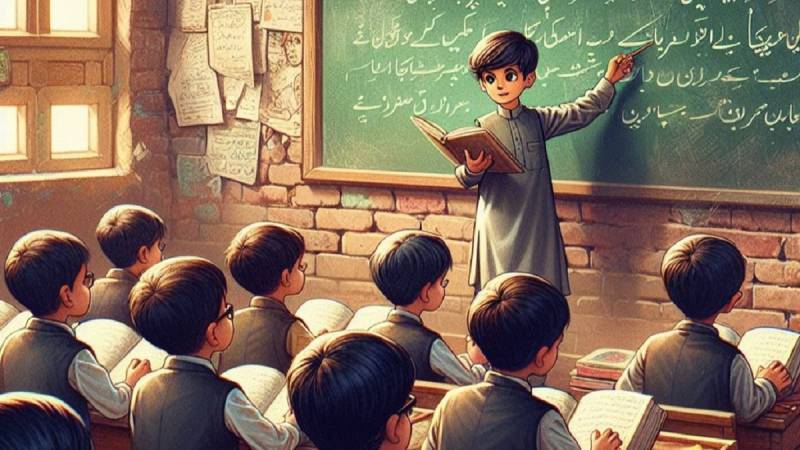
Pakistan's education system faces a myriad of challenges, with structural and policy flaws that have hindered its ability to deliver quality education to the nation. Despite numerous policy initiatives, we continue to lag behind when it comes to key educational indicators such as literacy rates and school enrolment. Though the National Education Policy Framework 2018 had introduced several key updates aiming for improvements, it clearly ignored the need for skill development.
It is important to note that our curricula remain outdated with little regard for the demands of an ever-evolving world. For example, textbooks in Pakistan's public schools remain heavily focused on narrow versions of Pakistan Studies and Islamiyat, ignoring science, technology, and social studies. The curricula only foster an insular and outdated worldview that does not prepare students to compete globally.
Furthermore, a prominent barrier in the way of education reforms in our country is political interference. Political instability and frequent changes in government have led to inconsistent policy implementation, often abandoning long-term reforms in favour of short-term political gains. The Education Sector Reforms (2001-2006), launched during General Pervez Musharraf's military government, aimed to increase enrolment and improve education quality. However, the reforms were not sustained, and implementation was impeded by bureaucratic inefficiencies and a lack of accountability. According to the Pakistan Education Statistics Report 2018-19 , the country continues to fall short of its education-related targets, such as achieving universal primary education or improving gender parity in education.
Pakistan's spending on education in the year 2023 was about 1.8686% of its gross domestic product (GDP). While this is an increase from the previous year, it still falls short of the recommended 4-6% of GDP
In addition to this, our education system is an amalgamation of multiple streams comprising public schools, madrasas, and private schools offering international education. This diverse system often follows different curricula, creating a fragmented and dissimilar educational experience for students. Keeping this in mind, it is safe to say that a stark disparity exists between the quality of education offered by public and private schools. Unfortunately, the country's education policy has failed terribly to bridge the growing gap between the private and the public schools. The decaying quality of public schools, particularly in urban areas, has increased the reliance on private schools, inflaming social inequality. Private schools are often perceived as having a higher standard of education, with qualified teachers, updated curricula, and modern facilities. However, the high cost of private education makes it inaccessible for a majority of the country's population, which is why a vast number of students are forced to attend government-run schools where resources are scarce, teachers are underpaid, and learning outcomes are poor.
Pakistan's AI Aspirations: Is No Policy Better Than (Any) Policy?
The Annual Status of Education Report (ASER) 2019 revealed that while literacy rates in urban areas have been improving, public schools in rural areas continue to face high dropout rates and low literacy levels. The report also found that students from private schools performed relatively better in reading and arithmetic skills than their public school counterparts. This growing divide sheds light on the failure of Pakistan's education policy to provide rightful access to quality education for all students, regardless of their socio-economic background.
Moreover, education in our country suffers from chronic underfunding, leaving it under-resourced and struggling to meet the needs of its growing population. Despite promises to increase the education budget, the government has only allocated Rs103.781 billion for Education Affairs and Services in the fiscal year 2024-25, which is an increase of less than 1% (0.9%) from the revised allocation of Rs103.684 billion for the current fiscal year. According to the World Bank, Pakistan's spending on education in the year 2023 was about 1.8686% of its gross domestic product (GDP). While this is an increase from the previous year, it still falls short of the recommended 4-6% of GDP. This underfunding leads to overcrowded classrooms, outdated textbooks, poor school infrastructure, and insufficient teacher training, contributing to the low quality of education. The National Education Policy 2017 , while acknowledging the need for increased investment, has also terribly failed in securing the necessary financial resources. The policy calls for the "enhancement of education budgets," but without a clear, actionable plan for increasing the allocation of resources, these calls remain largely rhetorical.
The Dire State Of Higher Education In Pakistan
In many rural areas of the country, schools lack basic facilities such as electricity, clean drinking water, and proper sanitation facilities. The Pakistan Education Statistics Report 2021-22 found that around 50% of public schools lack basic toilet facilities, and many lack proper classrooms.
Earlier this year, the education ministry finally showed some interest in formulating a new education policy, but that too was erroneously crafted. The policy touched upon some elements of skill development, but once again the approach remains inadequate and unfocused
One of the most glaring flaws of our education system is the unequal access to quality education. According to the Pakistan Education Statistics for 2021-22, some 26.2 million children are out of school. In terms of percentage, 39% of children of school-going age are out of school. Among the four provinces, Khyber Pakhtunkhwa (30%) has the lowest percentage of out-of-school children as a proportion of its school-going age population.
Moreover, gender disparity also aggravates this issue. Per UNICEF, girls — specifically in rural and tribal areas — face numerous barriers to acquiring an education. Socio-cultural demand-side barriers, combined with economic factors and supply-related issues (such as the availability of school facilities close to their home), together hamper access and retention of certain marginalised groups, in particular adolescent girls. The Pakistan Education Statistics Report 2019 also revealed that girls in rural areas are more likely to stay out of school than boys, while early marriage and cultural norms often prevent girls who do go to schools from completing their education. This results in Pakistan having one of the lowest female literacy rates in South Asia.
There is no doubt about the fact that the National Education Policy 2009 and the National Education Policy 2017 emphasise the importance of teacher quality and professional development. However, despite these commitments, no practical implementation has ever been witnessed, undermining any progress in improving teaching standards. The Teacher Development Programme (TDP), envisioned under the Education Sector Plan 2019-2025, has seen limited impact due to continuous underfunding and indigent enforcement. The Pakistan Education Statistics 2018-19 revealed that a large number of teachers, mainly in rural areas, remain undertrained and ill-equipped to meet the latest educational requirements.
Pakistan's Education Crisis: Barriers, Inequality And The Path To Reform
However, earlier this year, the education ministry finally showed some interest in formulating a new education policy, but that too was erroneously crafted. The policy emphasises the need to improve basic reading and numeracy skills for the country's children. The policy touched upon some elements of skill development, but once again the approach remains inadequate and unfocused. The framework lacks specific implementation plans or detailed strategies, as you say, to integrate technical and vocational education at the school level. There is no mention of incorporating STEM education and project-based learning programmes to develop critical thinking and practical problem-solving skills among students. The policy does not mention any non-academic initiatives.
There is a dire need to revamp the curricula, ideally focusing on the latest pedagogical practices and promoting the integration of digital tools and e-learning platforms to bridge the gap between urban and rural education
In this ever-evolving world, students need to learn in holistic environments that foster creativity, collaboration, and leadership alongside academic skills. Moreover, the policy fails to address the need for a modernised curriculum. Current frameworks continue to emphasise rote learning over critical thinking and problem-solving skills which is archaic. The policy has once again neglected the need for investment in teacher training. Many teachers in our country rely on outdated teaching methods and are not equipped to implement innovative pedagogical practices, further deteriorating the quality of education.
These systemic flaws can be addressed by developing a comprehensive education policy that is aligned with the United Nations Sustainable Development Goals (SDGs), especially SDG 4 which aims to " ensure inclusive and equitable quality education and promote lifelong learning opportunities for all ." Keeping SDG 4.1 in mind, we must keep universal access to education in mind, while paying special attention to marginalised groups such as girls, specially-abled children, and those living in rural areas. The government should focus on investing in the infrastructure of schools, particularly in rural and underserved areas, and ensure these schools are well-equipped with essential facilities. Additionally, the government could implement financial incentives to encourage parents to send their children to school, especially girls. Programmes like Nepal's Child Grant Programme, which provides cash transfers to families with children under 16 years old, contingent on school enrolment and attendance, can be introduced to reduce dropout rates. Moreover, we need to increase our education budget to at least 4% of GDP, as recommended by UNESCO, to meet the growing demand for education and improve infrastructure. We can take Bangladesh as an example, which increased its education budget to over 3% of GDP, leading to improved literacy rates.
NGO Takes 'Aim' At Pakistan's Biggest Problems Of Education, Clean Water
Keeping in mind SDG 4.4, which sheds light on the need to increase the number of youth and adults who have relevant skills, including technical and vocational skills, our educational policy must be implemented in a way that veers off from rote learning and glides towards creativity, critical thinking and digital literacy. There is a dire need to revamp the curricula, ideally focusing on the latest pedagogical practices and promoting the integration of digital tools and e-learning platforms to bridge the gap between urban and rural education. Public-private partnerships could help provide affordable devices and internet access to students in underserved areas.
Our education policy should focus on vocational training that aligns with labour market demands, offering opportunities for students to gain skills relevant to emerging sectors such as IT and healthcare
Furthermore, SDG 4.c stresses the importance of training and recruiting qualified teachers. Our National Policy Framework lacks a strategy for teacher recruitment, training, and continuous professional development to improve teaching quality. The government must establish mandatory teacher training programmes, focusing on subject-specific knowledge and pedagogical skills. Incentives must be offered, such as higher pay, housing allowances, and career development opportunities, to encourage qualified teachers to work in underserved and rural areas. Bearing in mind that SDG 4.3 — which provides access to affordable technical, vocational, and tertiary education, is crucial for economic development — we should also prioritise vocational education to meet the growing demand for skilled labour. Our education policy should focus on vocational training that aligns with labour market demands, offering opportunities for students to gain skills relevant to emerging sectors such as IT and healthcare. Additionally, SDG 5 calls for gender equality and the empowerment of all women and girls, and keeping this in mind we must address the gender gap in education by removing the cultural, social, and economic barriers that limit girls' access to education. Public campaigns to change societal attitudes towards girls' education must also be included in our education policy.
Who Will Save The Children Of Pakistan When It Comes To Education?
Our current education policy framework lacks a structured approach towards vocational and technical education, which is essential for skill-building. To tackle this issue, relevant courses in secondary schools must be introduced with industry collaboration for internships and certifications. In Germany, a dual vocational training system combines classroom learning with on-the-job training, equipping students with practical skills aligned with market needs. In addition to this, the policy does not provide a solution to counter rote learning, which limits critical thinking and problem-solving skills. This can be countered by revamping the curricula, encouraging inquiry-based learning and experiential education. Another gap seen in the policy is that it does make use of technology to expand educational access. As India has developed DIKSHA (a platform that offers digital resources for teachers and students, addressing educational gaps in remote areas), we must also develop a digital education platform offering online courses, teacher resources and learning tools.
To sum it all up, we need a policy that is inclusive, forward-looking, and capable of addressing the challenges Pakistan's education system faces. The government must create a clear, sustainable plan that includes adequate funding, infrastructure development, and a curriculum that is aligned with modern global standards. The integration of SDGs into Pakistan's education framework offers a roadmap for transformative change. However, revamping the National Policy Framework is not only required, but its implementation is equally essential.
The author is a research writer and policy analyst with a focus on social policy, governance, and sustainable development. Follow her on X: @amalsyed1 .
Subscribe Newsletter
Facebook comments, related news, 'election disputes are not civil disputes between two private parties', perspectives on pakistan versus india, beyond education: where character-building matters, how a politicized hec has contributed to degradation of higher ..., pakistan’s policy paralysis: bold plans, empty promises, the nab amendments judgment and cj isa's legacy, mubarak sani case: what has changed, can olympic records and javelin diplomacy thaw the ice between india ..., elections 2024: militablishment should accept defeat, reform is a political process. unelected elites and technocrats will ..., fact-check: is punjab cm maryam nawaz suffering from throat cancer, fact-check: did afghan consulate officials not stand for pakistan's ..., are justice tariq jahangiri's degrees fake, fact check: will govt shutdown social media apps on ashura, fact-check: did shahid afridi endorse ‘pro-israel’ event in ..., following alexander's conquest of sindh - ii.
- Sheikh Javed Ali Sindhi
Some Observations On The Chinese Model: Effective VS Acceptable ...
- Shahid Ahmed
Harmonious But Contradictory: Sindh’s Multi-Caste Villages
- Zaffar Junejo
Why Do We Really Need A Life Partner?
- M Aamer Sarfraz
Beginner’s Guide To Writing About Old Buildings
Climate crisis, lahore sees brief respite as air quality improves, remains 'unhealthy', what has punjab learned from its sister state, california.
- Ateer Bhatti
LHC Directs Punjab To Prioritize Smog Control, Calls For 10-Year Plan
The battle for breath: lahore's smog crisis and the cost of poor urban ..., more than money: the quality, quantity, and purpose of climate finance.
- Umaima Ahmed
Follow Us On Twitter

COMMENTS
Presentation Transcript. EDUCATION System in Pakistan 1. Constitution of Pakistan 2. Constitution of the Islamic Republic of Pakistan, 1973 - Article 37-b "The State shall remove illiteracy and provide free and compulsory secondary education within minimum possible period" Concurrent Legislative List: Curriculum, syllabus, planning ...
Presentation Transcript. EDUCATION System in Pakistan 5 December , 2008 1. Contents PART - I • Constitution of Pakistan • Organization & Functions PART - II • Education Scenario • Financing • Education Policy • Other Programmes 2. Constitution of Pakistan 3. Constitution of the Islamic Republic of Pakistan, 1973 - Article 37-b ...
In Pakistan, several types of institutions provide secondary-level education: (1) middle schools (G 1-8) which are established by upgrading primary schools; (2) secondary schools (G 6-10); and (3) higher secondary schools (HSSs) for grades 6 to 12. Schools are often upgraded to include higher grades.
education. In Pakistan (Punjab), 34 per cent of children aged between 12 and 14 have not completed primary education. Among this 34 percent who have not completed primary education, 49 per cent are males and 51 per cent are females. MICS6 in Pakistan (Punjab) The Pakistan (Punjab) Multiple Indicator Cluster Survey
Welcome to an exploration of Pakistan's educational journey, a voyage marked by both accomplishments and challenges. In this article, we'll embark on a comprehensive tour of Pakistan's education system, analyzing its setbacks and envisioning the road to academic excellence. Whether you're a student, a parent, or an education enthusiast ...
These issues collectively illustrate the systemic challenges embedded in Pakistan's education system. Tackling these hurdles demands a holistic approach, addressing infrastructure gaps, socio-economic disparities, policy execution, and societal mindsets toward education. The subsequent sections will delve into specific problems within various ...
This publication describes the key issues facing the school education system in Pakistan, highlights the challenges, and suggests some possible directions for reform—with a focus on two provinces: Sindh and Punjab. While average years of schooling in Pakistan have increased along with life expectancy and per capita income,
A primary school in a village in the Sindh region. Only about 67.5% of Pakistani children finish primary school education. [16] The standard national system of education is mainly inspired from the English educational system. Pre-school education is designed for 3-5 years old and usually consists of three stages: Play Group, Nursery and Kindergarten (also called 'KG' or 'Prep').
Abstract. In Pakistan, all children between 5 and 16 years of age have the right to 12 years of school education. The public school system is the main provider of schooling. Pakistan takes explicit account of gender in the provision of schooling, especially in public schools at post-primary levels, with girls' schools with female teachers and ...
One of the most glaring flaws of our education system is the unequal access to quality education. According to the Pakistan Education Statistics for 2021-22, some 26.2 million children are out of school. In terms of percentage, 39% of children of school-going age are out of school. Among the four provinces, Khyber Pakhtunkhwa (30%) has the ...